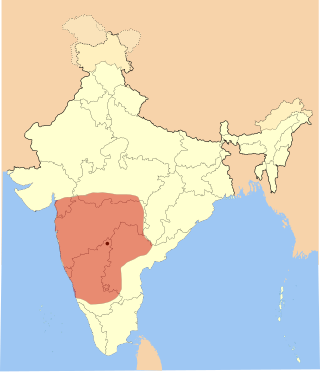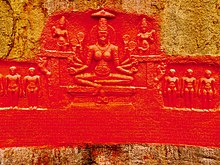
The Kakatiya dynasty was an Indian dynasty that ruled most of eastern Deccan region in present-day India between 12th and 14th centuries. Their territory comprised much of the present day Telangana and Andhra Pradesh, and parts of eastern Karnataka, northern Tamil Nadu, and southern Odisha. Their capital was Orugallu, now known as Warangal.

Lakkundi, also referred to as Lokkugundi, was a major city prior to the 14th century, and is now a village in Gadag District of Karnataka, India. By 10th century, it was already a major economic and commerce center with mint operations for South India, one mentioned in Kannada and Sanskrit inscriptions and texts. By 12th century, many Hindu and Jain temples had been consecrated here, along with public infrastructure such as stepwells and water reservoirs. Among the major temples are the Brahma Jinalaya (oldest), Mallikarjuna, Lakshminarayana, Manikeshwara, Naganatha, Kumbheshvara, Nanneshwara, Someshwara, Narayana, Nilakanteshwara, Kasivisesvara, Virabhadhara, Virupaksha, and others. As its importance and wealth grew, Lakkundi became one of the capitals of the Hoysala Empire.

Eastern Chalukyas, also known as the Chalukyas of Vengi, were a dynasty that ruled parts of South India between the 7th and 12th centuries. They started out as governors of the Chalukyas of Badami in the Deccan region. Subsequently, they became a sovereign power, and ruled the Vengi region of present-day Andhra Pradesh until c. 1001 CE. They continued ruling the region as feudatories of the Medieval Cholas until 1189 CE.

Tailapa II, also known as Taila II and by his title Ahavamalla, was the founder of the Western Chalukya dynasty in southern India. Tailapa claimed descent from the earlier Chalukyas of Vatapi (Badami), and initially ruled as a Rashtrakuta vassal from the Tardavadi-1000 province in the modern Bijapur district of Karnataka. When the Rashtrakuta power declined following an invasion by the Paramara king Siyaka, Tailapa overthrew the Rashtrakuta king Karka II, and established a new dynasty.

The Western Chalukya Empire ruled most of the western Deccan, South India, between the 10th and 12th centuries. This Kannadiga dynasty is sometimes called the Kalyani Chalukya after its regal capital at Kalyani, today's Basavakalyan in the modern Bidar District of Karnataka state, and alternatively the Later Chalukya from its theoretical relationship to the 6th-century Chalukya dynasty of Badami. The dynasty is called Western Chalukyas to differentiate from the contemporaneous Eastern Chalukyas of Vengi, a separate dynasty. Prior to the rise of these Chalukyas, the Rashtrakuta empire of Manyakheta controlled most of Deccan and Central India for over two centuries. In 973, seeing confusion in the Rashtrakuta empire after a successful invasion of their capital by the ruler of the Paramara dynasty of Malwa, Tailapa II, a feudatory of the Rashtrakuta Dynasty ruling from Bijapur region defeated his overlords and made Manyakheta his capital. The dynasty quickly rose to power and grew into an empire under Someshvara I who moved the capital to Kalyani.
Indra III was the grandson of Rashtrakuta Krishna II and son of Chedi princess Lakshmi. He became the ruler of the empire due to the early demise of his father Jagattunga. He had many titles such as Nithyavarsha, Rattakandarapa, Rajamarathanda and Kirthinarayana. He patronised Kannada poet and commander SriVijaya and Sanskrit poet Trivikrama. Indra III was married to princess Vijamba of the Kalachuri dynasty of central India (Chedi).
Govinda IV was the younger brother of Amoghavarsha II. He became the Rashtrakuta emperor in 930 as described in the Kalasa record of Chikmagalur. He was a very unpopular ruler who indulged in licentious acts. Control over Kannauj was lost during his rule. The Chalukyas of Vengi defeated him and much territory was lost. Finally, his own feudatories including King Arikesari of Vemulavada revolted against him and placed Amoghavarsha III on the throne in 935. This is known from the records of Kannada poet Adikavi Pampa, who was patronised by King Arikesari. Govinda IV had matrimonial relationship with the Cholas of Kanchi and finally found refuge with them when his feudatories revolted. Govinda IV patronised Kannada poet Ravinagabhatta.

Pampa, called by the honorific Ādikavi was a Kannada-language Jain poet whose works reflected his philosophical beliefs. A court poet of Vemulavada Chalukya king Arikesari II, he was a feudatory of the Rashtrakuta dynasty king Krishna III. Pampa is best known for his epics Vikramārjuna Vijaya or Pampa Bharata, and the Ādi purāṇa, both written in the champu style around c. 939. These works served as the model for all future champu works in Kannada.

The Kasivisvesvara temple, also referred to as the Kavatalesvara, Kashivishveshvara or Kashi Vishvanatha temple of Lakkundi is located in the Gadag district of Karnataka state, India. It is about 12 kilometres (7.5 mi) from Gadag city, between Hampi and Goa. The Kasivisvesvara temple is one of the best illustrations of fully developed Kalyana Chalukya style of Hindu architecture.
Somadeva Suri was a south Indian Jain monk of the 10th century CE, author of a work known as "Upasakadyayana" "chapter on lay followers (upasakas)", a central work of Digambara shravakacara literature, i.e. instructions and prescriptions for shravakas or Jain lay followers.
Vinayaditya alias Yuddhamalla I, was an Indian ruler from the Vemulavada Chalukya dynasty. He was most probably a vassal of the Rashtrakuta king Dantidurga, and his capital was likely located at Podana ; his successors moved the capital to Vemulavada.
Arikesari I was an Indian ruler from the Vemulavada Chalukya dynasty. He was a vassal of the Rashtrakuta king Dhruva Dharavarsha and appears to have helped his overlord subjugate the Vengi Chalukya ruler Vishnuvardhana IV.
Baddega, who assumed the title Solada-gaṇḍa, was an Indian ruler from the Vemulavada Chalukya dynasty. He was a vassal of the Rashtrakuta king Krishna II, and participated in Krishna's unsuccessful invasions of the Vengi Chalukya kingdom.
Narasimha II was a ruler of the Vemulavada Chalukya dynasty of present-day Telangana, India. As a vassal of the Rashtrakuta king Indra III, he led an Rashtrakuta army against the Gurjara-Pratihara king Mahipala. According to his dynasty's records, he advanced as far as Ganges river in the north, forcing Mahipala to flee.
Arikesari II was a ruler of the Vemulavada Chalukya dynasty of present-day Telangana, India. A Rashtrakuta vassal, he played an important role in dethroning the Rashtrakuta emperor Govinda IV and enthroning Amoghavarsha III as the new emperor. He was the patron of Pampa, one of the earliest notable Kannada-language poets.
Arikesari III was the last known ruler of the Vemulavada Chalukya dynasty of present-day Telangana, India. He was a vassal of the Rashtrakuta king Krishna III.

Bommalagutta is a Jain centre situated near Kurikyala village of Karimnagar district in Telangana. This Jain center is situated 3 km from another famous Jain center Kulpakji.
Gunda III, also known as Gundyana or Gundana, was a member of the Kakatiya dynasty of southern India. He served the Rashtrakuta king Krishna II, and died during Krishna's invasion of the Vengi Chalukya kingdom. He is the earliest known member of the Kakatiya family to have been in the Telugu-speaking region.
Gunda IV alias Pindi-Gunda was a member of the Kakatiya dynasty of southern India. As a Rashtrakuta general, he helped the Vengi Chalukya prince Danarnava ascend the throne after a succession dispute. In 973 CE, after the collapse of the Rashtrakuta empire and the murder of Danarnava, he attempted to carve out an independent principality at Kuravi. The Kalyani Chalukyas, who had usurped the power from the Rashtrakutas, probably defeated and killed him, supported by the Mudugonda Chalukyas, the former rulers of Kuravi.
Prola I was a member of the Kakatiya dynasty of southern India. As a Kalyani Chalukya vassal, he participated in prince Vikramaditya VI's campaigns, and consolidated the Kakatiya control over the area around Anumakonda by subjugating local chiefs. He obtained the Anumakonda vishaya and its neighbouring lands as a hereditary fief from the Chalukya king.









